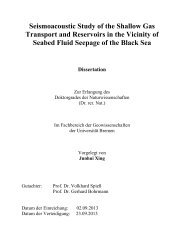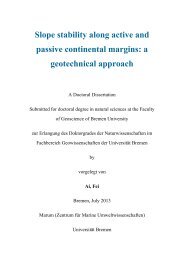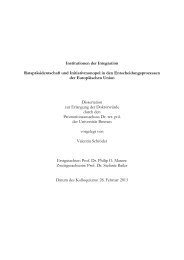aus dem MARUM und dem Fachbereich Geowissenschaften der ...
aus dem MARUM und dem Fachbereich Geowissenschaften der ...
aus dem MARUM und dem Fachbereich Geowissenschaften der ...
Create successful ePaper yourself
Turn your PDF publications into a flip-book with our unique Google optimized e-Paper software.
MARIA S. MERIAN-Berichte, Cruise 20, Leg 4, Bridgetown – Freeport, 15.3.2012 – 7.4.2012 5<br />
MPI Hamburg: F. Jansen; SaM: A. Freiwald; GEOMAR: C. Dullo; <strong>MARUM</strong>: D. Hebbeln). In<br />
addition, on S<strong>und</strong>ay we interrupted our transit for ~4 hours to do a test station (GeoB 16301) for<br />
the CTD and the ROV CHEROKEE. On Tuesday, the vessel stopped for a second time to deploy<br />
the depressor of the ROV in or<strong>der</strong> to test the positioning system POSIDONIA (GeoB 16302).<br />
Wednesday, March 21, 2012 ◊ In the morning, we eventually arrived Mexican waters<br />
(Yucatan peninsula) and started station work with a CTD cast down to a water depth of 1,100 m<br />
(GeoB 16303). We continued our work with MBES and PARASOUND mapping (GeoB 16304)<br />
along the eastern slope of the Campeche Bank heading towards our first "potential" CWC site in<br />
water depths of 500-600 m along the NE Campeche Bank. This area was initially mapped in 2009<br />
during R/V METEOR cruise M78-1 (chief scientist: J. Schönfeld, GEOMAR) revealing<br />
conspicuous seabed structures up to 40-m-high, which strongly resemble CWC mo<strong>und</strong>s along the<br />
NE Atlantic margin, however, any gro<strong>und</strong>truthing was lacking. Evaluating the origin of these<br />
seabed elevations by ROV video observation and sediment sampling was the first target of cruise<br />
MSM 20-4. In the evening, we arrived the area, accomplished another CTD cast (GeoB 16305),<br />
and continued mapping (GeoB 16306) to get an adequate bathymetric map to plan an ROV dive.<br />
Thursday, March 22, 2012 ◊ During mapping, we discovered 25-m-high NW-SE-elongated<br />
seabed structures in water depths between 550 and 600 m along the slope of the Campeche Bank.<br />
These structures were the first target for an ROV dive (GeoB 16307). The video observation<br />
revealed that these structures are covered by live and dead CWC framework. However, due to<br />
strong bottom currents, it was not possible to sample the CWC by the ROV. Nevertheless, after<br />
recovery of the ROV, we discovered some live and dead branches of Lophelia entangled in the<br />
ROV's depressor weight. We continued station work with sediment sampling with the box corer.<br />
Whereas two box cores yielded only few sediment with fossil coral framework (GeoB 16308,<br />
16309), a third box corer recovered muddy sediments dispersed by coral rubble (GeoB 16310-1).<br />
A gravity core, taken from the same position, was filled over the top (GeoB 16310-2). However,<br />
a second attempt with a 12-m-long core barrel yielded a coral-bearing sediment core with a total<br />
recovery of 10.60 m (GeoB 16310-3). During the night, we continued mapping (GeoB 16311) in<br />
the northern part of the working area and again discovered numerous ridge structures.<br />
Friday, March 23, 2012 ◊ In the morning, we deployed the ROV (GeoB 16312) and<br />
observed that all ridge tops are colonised by live CWC, whereas the ridge troughs are dominated<br />
by muddy sediments and coral rubble. We selected one ridge structure for sampling with the box<br />
and gravity corers (GeoB 16313). One attempt to collect a so-called "off-mo<strong>und</strong>" sediment core<br />
(barren of any coral fragments to get a continuous sedimentary record for palaeo-environmental<br />
reconstructions) failed (GeoB 16314), a further attempt to obtain such a core was postponed to<br />
the next day. A last sampling target for this day was a crater-like structure which has been<br />
discovered during mapping eastward of the coral ridges in a water depth of ~620 m.<br />
Unfortunately, sampling with the box corer failed (GeoB 16315) as the corer tilted on the<br />
seafloor and had to be recovered upside down as the cable of the winch got entangled with the<br />
frame of the box corer. However, the deck's crew and technicians together managed to recover<br />
the corer safe back on board and the corer revealed just minor damage which could be repaired<br />
until the next day. During the night, a so-called Yoyo-CTD was conducted (GeoB 16316) during<br />
which the CTD was repeatedly lowered over a period of 13 hours to obtain changes in physical<br />
parameters of the water column during a full tidal cycle.<br />
Saturday, March 24, 2012 ◊ We started the day with an ROV dive (GeoB 16317) in the<br />
northern, slightly shallower (450-550 m) part of the Campeche area. As during the dives before,

















